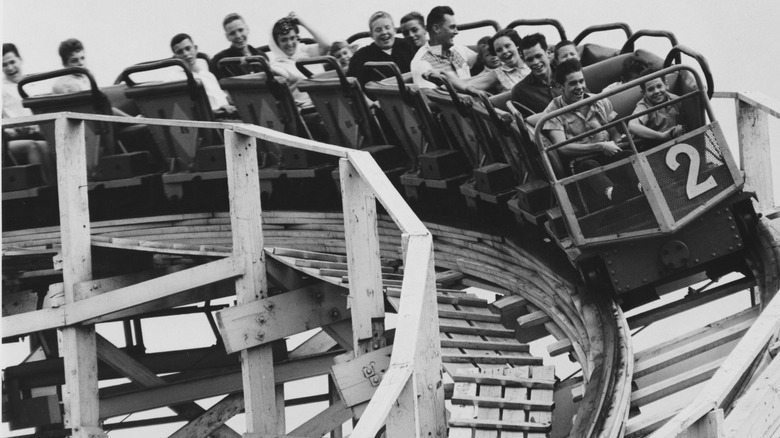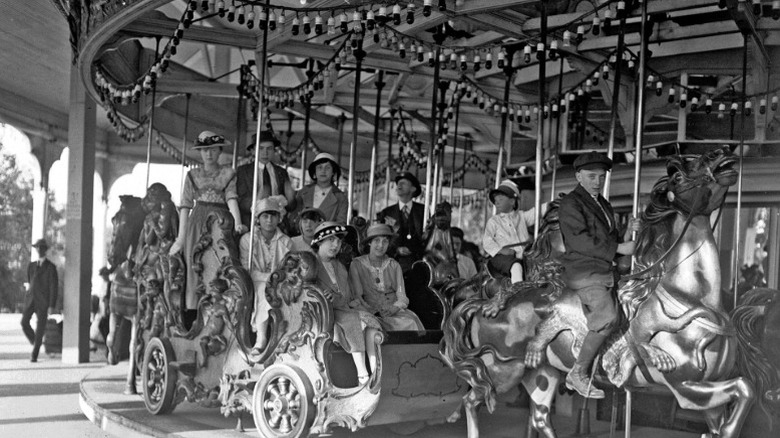Chicago's Once-Thriving Amusement Park Was A Historic Landmark That Closed Suddenly And Disappeared
That Chicago known for industrial meatpacking, blustering politicians, a massively destructive Great Fire, and "Tool Maker, Stacker of Wheat, Player with Railroads and Freight Handler to the Nation," as poet Carl Sandburg once mythologized? It's also good old-fashioned American fun in the key of Midwestern gee whiz, flipping pinball innovations next level up and inventing candy like Cracker Jack, M&Ms, Snickers, and more. It also souped up the blueprint for bodacious amusement park thrills and zeal that still characterize modern renditions. In the midst of the city's elegant 1893 World's Fair, a mile-long midway of light-hearted diversions and corny showmanship unfurled, including the debut of the Ferris wheel, proving that light-hearted distractions also belong in urban centers. By 1908, Chicago housed the most amusement parks in the country, but only the once-thriving Riverview grips the city's nostalgic soul.
Inspired by Copenhagen's legendary Tivoli Gardens, one of Europe's 12 highest-rated theme parks, and Vienna's beloved centuries-old Prater, the Schmidt family opened Riverview Park in 1904 by the Chicago River's North Branch, easily reached from any part of town. Within a decade, the self-proclaimed "world's largest amusement park" grew into a 140-acre barrel of fun filled with myriads of rides, food, performances, games, and music. More than an entertainment destination, the Riverview was a 20th-century historic landmark of lifelong memories for millions of visitors yearly: first kisses in the Tunnel of Love, youthful mischief (innocent and otherwise), pre-social media social arena.
The park's features were losing their luster, and teenage escapades were perceived as unsavory by the 1960s. But it was the unexpected sale of its prime location land that led to its sudden closure. Like a gag gone wrong in its Aladdin's Castle funhouse, one day the Riverview was sparkling with its usual exuberance, the next, it had disappeared for good.
The historic Riverview Park inspired lifelong memories for Chicagoans
Blazing the trail for the best amusement parks in the U.S. today, Riverview Park was never a one-trick pony in a one-chariot carousel. Daredevils were spoilt for choice: Would it be splashing into water on Shoot the Chutes or rearranging your center of gravity on the twisty Flying Turns swings and Pair-O-Chutes free fall? Coaster connoisseurs went to town on the Velvet Coaster, the Blue Streak, and the hair-raising Bobs that soared 50 mph and dived almost 80 feet. Another major Riverview invention is that "click-click-click" synonymous with roller coasters, an anti-rollback mechanism designed by engineer John A. Miller for the park so these rides fly higher and faster while staying secured to the track. And believe it or not, one of the park's three original showcases still delights: A specially commissioned merry-go-round masterpiece with 72 hand-carved horses and four chariots, added to the National Register of Historic Places in 1995, now spins at Six Flags Over Georgia in Atlanta.
In its 63 years, the Riverview was enough of a cultural institution to also reflect the times. Attractions that thankfully belong to the past, together with the park, include a funhouse air hose that blew women's skirts up, the "Freak Show" of people with disabilities and perceived divergences, and politically incorrect imagery and stunts. Yet it was a rite (and ride) of passage for Chicagoans of a time when sensational whirls beyond one's wildest dreams preceded air travel to exotic vacations, and a worry-free hangout meant unbridled freedom from parents. To relive what the Riverview meant to the city, check out Navy Pier, Chicago's year-round waterfront playground full of rides, food, shops, and of course, a Ferris Wheel peaking at 196 feet.

